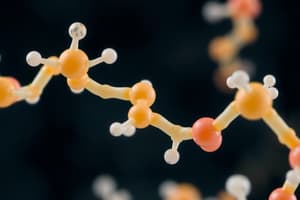Podcast
Questions and Answers
What is the primary source of energy for the brain and erythrocytes?
What is the primary source of energy for the brain and erythrocytes?
- Glucose (correct)
- Fructose
- Galactose
- Ribose
What is the normal range of blood glucose level in the body?
What is the normal range of blood glucose level in the body?
- 200-300 mg/dl
- 100-200 mg/dl
- 50-100 mg/dl
- 70-140 mg/dl (correct)
What is the main form of carbohydrate absorption in the body?
What is the main form of carbohydrate absorption in the body?
- Galactose
- Sucrose
- Glucose (correct)
- Fructose
What is the function of fructose in seminal fluid?
What is the function of fructose in seminal fluid?
What is the role of ribose in nucleic acids?
What is the role of ribose in nucleic acids?
What is the main difference between starch and cellulose?
What is the main difference between starch and cellulose?
What is the primary storage form of glucose in animals?
What is the primary storage form of glucose in animals?
What is the byproduct of bacterial action on sugars in the mouth?
What is the byproduct of bacterial action on sugars in the mouth?
What is the role of salivary amylase in the mouth?
What is the role of salivary amylase in the mouth?
What is the primary source of energy for cows?
What is the primary source of energy for cows?
Flashcards are hidden until you start studying
Study Notes
Polymers and Carbohydrates
- Monomers form larger molecules by condensation reactions called dehydration reactions, removing a water molecule and forming a new bond.
- Dehydration reaction is the process of forming a polymer.
- Polymers can disassemble by hydrolysis, adding a water molecule and breaking a bond.
- Carbohydrates are biomolecules consisting of carbon, hydrogen, and oxygen atoms, usually with the general formula Cn(H2O)n = CnH2nOn.
Importance of Carbohydrates
- Carbohydrates are the chief source of energy.
- They are important structural components in animal and plant cells.
- They are important parts of nucleic acids, free nucleotides, and coenzymes.
- Major antigens are carbohydrates in nature, e.g., blood group substances.
- They have biological roles as part of hormones and their receptors and enzymes.
Classification of Carbohydrates
- Carbohydrates can be classified according to the hydrolysis products.
- Monosaccharides cannot be hydrolyzed into smaller units.
- Disaccharides can be hydrolyzed into two monosaccharides.
- Oligosaccharides can be hydrolyzed into 3-10 monosaccharides.
- Polysaccharides can be hydrolyzed into more than 10 monosaccharides.
Macromolecules
- Macromolecules are large molecules consisting of many smaller structural units linked together by a process called dehydration synthesis.
- All biological macromolecules are made up of a small number of elements: carbon, hydrogen, oxygen, nitrogen, and phosphorus.
- Polymers are chain-like molecules called macromolecules formed by covalent bonds between monomers.
Monosaccharides
- Monosaccharides are the simplest carbohydrates, composed of a single sugar unit according to the formula CnH2nOn.
- Monosaccharides can be classified according to the number of carbon atoms present in the monosaccharide.
- Monosaccharides can be classified according to whether they contain an aldehyde or keto group.
Stereochemistry of Carbohydrates
- Stereoisomers are compounds having the same structural formula but differing in the arrangement of atoms in the molecule in space.
- Chiral carbon is a carbon atom attached to four different groups.
- Optical activity is the ability of a chiral molecule to rotate the plane of plane-polarized light.
Monosaccharides of Biological Importance
- Glucose is a major source of energy for humans and animals.
- The body maintains a fairly constant blood glucose level of 70-140 mg/dl at all times.
- Glucose can be converted into other sugars in the liver and other tissues.
- Galactose is synthesized in the mammary gland to form the disaccharide lactose.
- Fructose is present in semen and is a constituent of the disaccharide sucrose.
- Ribose forms part of the structural backbone of nucleic acids RNA and DNA.
Disaccharides and Polysaccharides
- Disaccharides are composed of two monosaccharides joined by a covalent bond.
- Common disaccharides are sucrose, lactose, and maltose.
- Starch is a polymer consisting entirely of glucose monomers.
- Glycogen is the major storage form of glucose in animals.
- Cellulose is a polymer of glucose with different glycosidic linkages than starch.
Sugars and Dental Caries
- Sugars, after being hydrolyzed by salivary amylase, provide substrate for the actions of oral bacteria.
- Oral bacteria produce excess amounts of acid, which starts attacking tooth enamel, eventually leading to cavities and tooth decay.
Studying That Suits You
Use AI to generate personalized quizzes and flashcards to suit your learning preferences.




